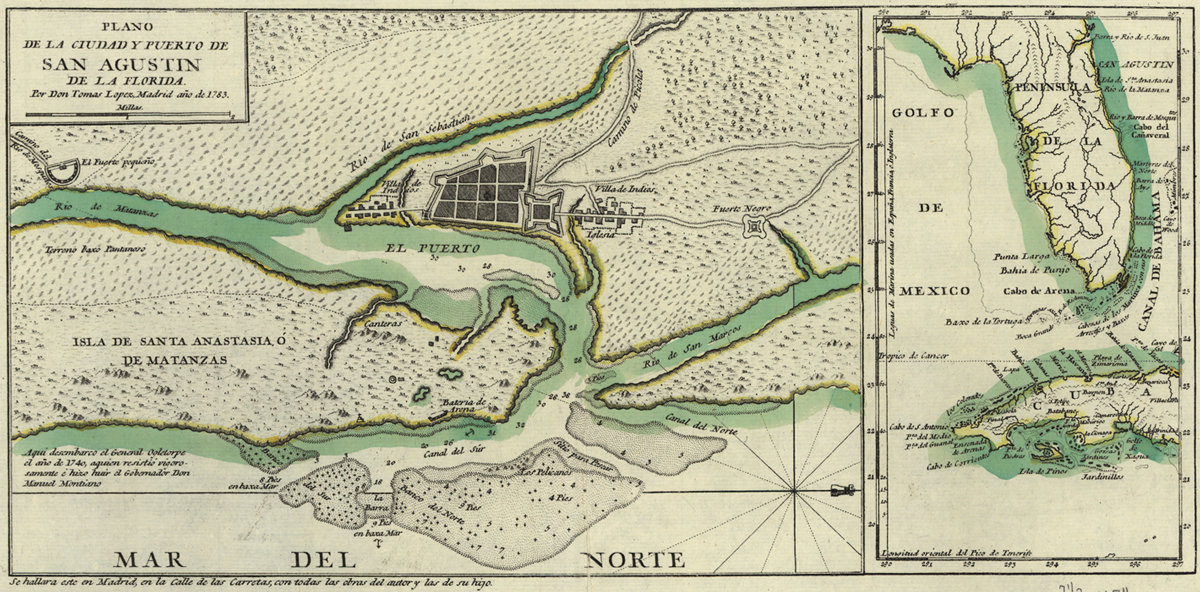(Library of Congress, Parallel Histories: Spain, the United States, and the American Frontier)
An eighteenth-century map shows the plan of St. Augustine, the capital of the Spanish colony of Florida. The location of Fort Mose, which was established in 1738 and was home to a militia consisting of men who had escaped enslavement in the English colonies to the north, is labeled Fuerte Negro.
In 1715, a Mandinga man from the Gambia region of West Africa who would go down in history under the name Francisco Menéndez escaped from enslavement in the English colony of South Carolina to join up with local Native Americans, the Yamasee, who were waging war against his former captors. Menéndez fought alongside the Yamasee for a few months. At times, the Yamasee came close to driving the English out of the Carolinas, but superior colonial reinforcements eventually arrived. Later in 1715, Menéndez and several other formerly enslaved people, likely including his Mandinga wife, guided by their Yamasee comrades, traveled south toward St. Augustine, the capital of the Spanish colony of Florida. They had heard that the Spanish king had promised freedom to people fleeing slavery—provided they converted to Catholicism.
Enslaved people seeking liberty had sought refuge in St. Augustine since at least 1687, when eight men, two women, and a young child arrived by boat from the Carolinas. An edict issued by Spain’s King Charles II (reigned 1665–1700) in 1693 giving “liberty to all” formalized the Spanish policy of welcoming formerly enslaved people, and their numbers increased as word of the proclamation spread. Menéndez’s journey to freedom, however, was interrupted when a Yamasee man known as Perro Bravo, or Mad Dog, claimed ownership of him and several others who had fought against the English in the Carolinas. The acting governor of Florida purchased the hostages, and Menéndez was later sold at auction to the royal accountant, Francisco Menéndez Márquez, whose name he adopted at his Catholic baptism. The royal accountant became Menéndez’s godparent and entrusted him with a great deal of responsibility. Still, Menéndez filed multiple petitions with Spanish authorities protesting his continued enslavement, to no avail. “Even though he’s in a very important household, that of one of the most important officers in St. Augustine, Menéndez is still not free like he is supposed to be,” says historian Jane Landers of Vanderbilt University.
Relations between the Spanish and English colonies were always tense and often erupted into armed conflict. By offering escaped slaves their freedom, the Spanish struck an economic blow against the English, depriving them of a valuable labor force. They took advantage of the new arrivals’ hatred of their former English enslavers to strike a military blow as well. “Who would be more resistant to the British than those who had been enslaved by them?” asks Landers. In 1726, Florida Governor Antonio de Benavides appointed Menéndez commander of a newly formed militia composed of formerly enslaved people. This fighting force played a key role in defending St. Augustine against an English invasion in 1728.
More than 100 escapees had made their way from the English colonies to St. Augustine by 1738. That year, a new Florida governor, Manuel de Montiano, reviewed Menéndez’s latest petition, which included testimony from a Yamasee leader regarding his bravery in the fight against the English in South Carolina and blaming his continued enslavement on the “infidel” Mad Dog. Montiano granted unconditional freedom to Menéndez and other escapees who had been re-enslaved in Florida. The governor also moved Menéndez’s militia to a newly established town two miles north of St. Augustine that he named Gracia Real de Santa Teresa de Mose, known today as Fort Mose. There, the militia would serve as the northernmost defenders of the Spanish colonial capital against British attacks.
The initial settlement at Fort Mose was decidedly small-scale. The walls of the square fort were made of earth and logs and measured just 70 feet or so on a side. The fort was surrounded by a moat and contained a lookout tower and a fortified house. In historical terms, however, Fort Mose looms large. It was the first legally sanctioned free Black town in the lands that would become the United States and thus holds great resonance for the area’s Black community today. “This was the first underground railroad,” says Landers. “And it went south, not to Canada.”


 LUND, SWEDEN—According to a statement released by
LUND, SWEDEN—According to a statement released by 